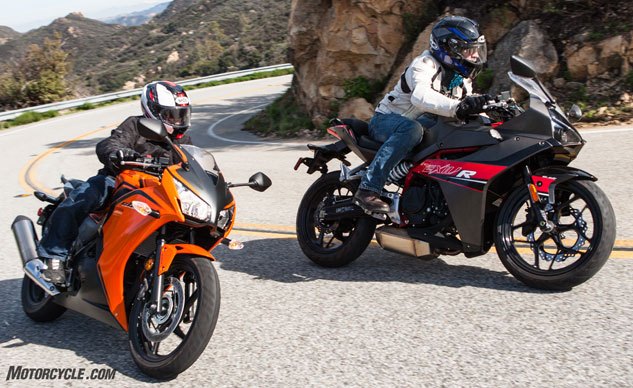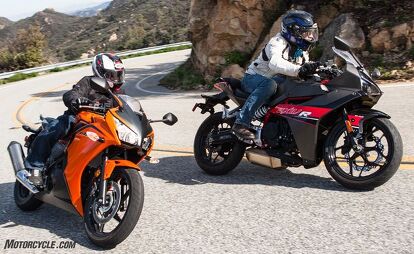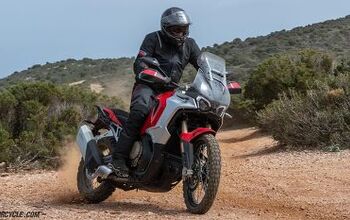2017 Honda CBR300R Vs. Hyosung GD250R

Two small-displacement Singles with completely different attitudes
There’s an old saying that aptly describes the Hyosung GD250R: A day late and a dollar short. The 250cc beginner bike market went strong for years without much of an update, as the Kawasaki EX/Ninja 250, and later the Honda CBR250, practically owned the category for nearly three decades. Hyosung wasn’t absent in the market, since it persisted with its GT250R (and the naked GT250, no R).
It was a pretty cool bike, too, sporting a V-Twin engine while the others had either a Single or parallel-Twin. But the problems facing the GT250 are three-fold, as noted in our 2011 250cc Beginner Bike Shootout: we couldn’t fully trust it in the handling department, it lacks in overall fit and finish, and its dimensions are much bigger than the Kawi or Honda, more akin to a full-size bike than one catered to a new rider. As a result, it’s a heavy motorcycle.
Now Hyosung has brought the GD250R to the table. A step up from the GT250, the GD’s 250 (well, 249cc) loses a cylinder compared to the GT and gains a radiator and the associated liquid-cooling that comes with it. There are two valves letting air in the combustion chamber and another two letting air out, operated by their own separate camshafts – all modern day stuff (get the full run down on it in John Burns’ review here). Its proportions are slimmer, too, inline with the others in its class.
The problem, of course, is that while the GD250R is finally a proper 250cc class competitor, the class has moved on to bigger and better things. The Ninja stalwart has grown to 300cc, while the Yamaha R3 is even bigger, at 321cc. And the 373cc in KTM’s RC390 further ups the segment’s displacement ceiling.
The Honda has bulked up, too. No longer a 250cc, the CBR300R sees a bore increase to bring its actual displacement to 286cc. But it is a sporty Single, just like the Hyosung. And while it has a significant 37 cubic-centimeter displacement advantage, it’s the closest current production model we have to a proper contender for the Hyosung. And just like that, we have a comparison test.
Before we go writing off the Honda as the winner due to its bigger engine, there are a few things to consider. First, the Honda lost the battle against its peers in our Beginner-ish Sportbike Shootout by a not insignificant margin. Second, and maybe more importantly, the GD250R costs less than the Honda. By quite a bit in this case, as the Hyosung will set you back $4,099 as opposed to the $4,499 Honda. Add ABS to the CBR (not an option on the Hyosung), like our test bike, and the price jumps another $500. That’s 5-large for a 286cc Single! It puts the Honda in a hole on the MO Scorecard right off the bat. Is it a disadvantage the Honda can claw itself out of, or will the Hyosung take advantage and grab an unexpected victory? Let’s find out.
Stating The Obvious
Okay, who are we kidding? The Honda is the better bike here. The Hyosung makes a reasonable argument only if saving money is a priority or if its edgy styling is enough to give it a subjective advantage for you.
Despite their similar concepts of a fully faired single-cylinder sporty motorcycle, the Honda “is way more a standard and the Hyosung wants to be a little sportbike,” says John Burns, creating what he calls an apples and oranges comparison. The Hyosung, as Burns explains in his single bike review, places the rider in a committed riding position thanks to clip-ons hung below the top triple clamp. This is emphasized by the spacers in the footpegs that place the rider’s feet further rearward. Removing the spacers would relax the knee bend, but you’re still leaning forward quite a way compared to the Honda.
Meanwhile, the Honda’s clip-ons are above the top triple, placing the rider more upright. Footpeg positioning is also more neutral compared to the Hyosung. Both are narrow enough to easily split lanes on the freeway, but the Honda will be more comfortable and won’t buzz your hands to sleep as readily as the GD.
Harsh? Maybe, but let’s examine why. We expected the CBR to win on the engine front by way of its displacement advantage. It does, but really, the Hyosung’s 23.4 hp keeps the Honda’s 26.3 hp honest. Also not surprising is the Honda’s mid-range grunt compared to the GD. The CBR’s 17.5 lb-ft isn’t much, but it feels more usable than the 15.6 lb-ft put down by the Hyosung. This helps big time when we’re talking about such modest power, especially when darting through traffic or trying to merge with other vehicles on the freeway.
We knew the engine comparison would be skewed in the Honda’s favor, but engine size doesn’t matter when it comes to transmission quality, and here the Honda shines through. Shifts are crisp and positive, swift flicks of the toe engaging each gear. The Hyosung, meanwhile, takes a little more effort and feels slightly vague. Fortunately it’s the only one of the two equipped with a gear position indicator – something we feel every bike should have, especially ones aimed at newer riders.
“Clutch is a tad grabby,” says John of the GD250. Other scribbles of notes include, “shifts longer-throw and less lubricious than the Honda.” Throttles are being turned to the stop 80% of the time on both bikes, but the CBR doesn’t feel like you’re testing the limits of wrist dexterity in the process. The same can’t be said for the long-turn throttle of the Hyosung. Annoyance points: GD250.
Vibration is another ding for the GD250. Both bikes are screaming around (and above) 8,000 rpm on the highway, creating a buzz through the bars, but comparatively speaking, vibration from the 300R is far less obtrusive than the Hyosung. After a long freeway jaunt, you’ll swear the GD stands for Gosh Darnit. Or something like that…
It’s not all doom and gloom for the Hyosung, though. Once the road gets squiggly, the GD250R comes into its own. Its sharper rake (23.5º vs. 25.3º), less trail (3.7 in. vs. 3.9 in.) and shorter wheelbase (53.0 in. vs. 54.3 in.) compared to the CBR, means the GD steers quickly into bends, making the CBR feel downright lazy in relation. It’s here, in the twisty stuff, where the Hyosung makes sense. The low clip-ons and rear-set pegs put you in the position to attack the next corner. Were it wearing slicks, you’d feel brave enough to attempt your best Marquez impression.
The CBR is no slouch in the grand scheme of things, as it turns and flicks fairly quickly relative to most bikes, and its midrange punch between the two gives it the jump from one corner to the next – at least if you were in a race with the Hyosung. Suspensions are fairly equal, too, with rear preload adjustments your only option. Cool points go to the GD250R for its inverted fork, but If we were to nitpick, the Hyosung’s initial stroke when hitting a bump is firmer than the Honda’s. It’s practically a non-issue unless you rode the two together. And even then Burns will argue neither suspension is really that bad.
Both bikes only have a single front brake disc – 296mm for the Honda, 300mm the Hyosung – but while the CBR gets by with a twin-piston caliper and rubber line, the GD is rocking a stylish four-piston caliper and steel-braided line. Surprisingly, neither had much of an advantage in overall braking power, but the 250R lacked lever feel. On the Scorecard this reads advantage Honda in the brake category, barely.
Noticing a Trend?
It might seem like we’re ganging up on the Hyosung, but the reality is, for nearly every subjective category on the trusty MO Scorecard, the Honda is simply better. It has the better engine, it’s more user friendly, and it has superior fit and finish – the same demerit that plagued the GT250. The Hyosung’s 2.9-gallon tank is smaller than the Honda’s 3.4 gallons, but it actually edged the Honda in fuel economy by a slim margin: 61 mpg vs. 59 mpg (of course, your mileage may vary depending on usage). However, the smaller tank obviously means you’ll be stopping for fuel sooner, and the fuel light comes on rather early – Burns reported it lighting up once after only 96 miles. After filling up he discovered there was still about half a gallon in the tank. Short of calling it a demerit, we’ll call the Hyosung’s pessimistic low-fuel light an annoyance.
When it comes to the Scorecard the GD250R handily beat the CBR in the Cool Factor category. Its sportier looks compared to the CBR’s rather vanilla styling gives it the appearance of something much more expensive. From the styling of the bodywork, which looks like a Triumph Daytona 675 knockoff, personally (which isn’t a bad thing), to the steel trellis frame, inverted fork, and even the wavy brake discs and steel lines, the Hyosung gives the intention that it’d rather be on a racetrack. There’s no denying the GD is the one eyeballs gravitate to when both are parked next to each other.
In some ways this was never a fair test for the Hyosung, as it was bound to lose out to the quality-control freaks at Honda. However, a cheaper price tag sometimes allows a motorcycle to get away with a couple sour spots as long as the overall package punches above its weight. Unfortunately for the GD250R, it doesn’t. While its price tag might be more attractive, we’d be inclined to recommend saving a little extra for the Honda.
In the end, JB leaves us with this: “The Hyosung is just a bit rough-edged but then I liked that about the Buells. So what can I say – except that the Hyosung makes a Buell feel like a Honda. Overall, if you needed to slog through L.A. traffic, you’d definitely take the Honda. In fact, you’d probably take the Honda wherever you were going.”
Honda CBR300R
+ Highs
- Comfortable riding position
- Better engine of the two
- Excellent fit and finish
– Sighs
- Five-grand is starting to get pricey…
- Styling’s a little bland
- Uh…Bueller?
Hyosung GD250R
+ Highs
- Killer looks
- The price is right, Bob
- Quick and agile handling
– Sighs
- Where were you when the other 250s were still playing?
- Buzzy engine
- Fit/finish not up to Honda levels
| ScoreCard | 2017 Honda CBR300R | 2017 Hyosung GD250R |
|---|---|---|
Price | 82.0% | 100.0% |
Weight | 98.1% | 100.0% |
lb/hp | 100.0% | 91.4% |
lb/lb-ft | 100.0% | 90.8% |
Total Objective Scores | 93.4% | 97.0% |
Engine | 91.3% | 81.6% |
Transmission/Clutch | 90.0% | 70.0% |
Handling | 80.0% | 82.5% |
Brakes | 85.0% | 80.0% |
Suspension | 77.5% | 75.0% |
Technologies | 65.0% | 60.0% |
Instruments | 82.5% | 72.5% |
Ergonomics/Comfort | 85.0% | 72.5% |
85.0% | 72.5% | |
Cool Factor | 72.5% | 82.5% |
Grin Factor | 80.0% | 72.5% |
John’s Subjective Scores | 83.8% | 77.1% |
Troy’s Subjective Scores | 80.4% | 73.3% |
Overall Score | 84.3% | 79.6% |
2017 Honda CBR300R | 2017 Hyosung GD250R | |
|---|---|---|
| MSRP | $4,499 – $4,999 (ABS, as tested) | $4,099 |
| Engine Type | 286cc liquid-cooled, single-cylinder, DOHC, four-stroke. 4-valves per cylinder | 249cc liquid-cooled, single-cylinder, DOHC, four-stroke, 4-valves per cylinder |
| Bore and Stroke | 76mm x 63mm | 73.0mm x 59.6mm |
| Compression Ratio | 10.7:1 | 12.0:1 |
| Rear Wheel Horsepower | 26.3 hp @ 8,400 rpm | 23.5 @ 10,700 rpm |
| Torque | 17.5 lb-ft @ 6,700 rpm | 15.6 lb-ft @ 7,100 rpm |
| Transmission | 6-speed | 6-speed |
| Final Drive | Chain | Chain |
| Front Suspension | 37mm conventional fork. Non-adjustable | 37mm inverted fork. Non-adjustable |
| Rear Suspension | Pro-link single shock, preload adjustable | Monoshock w/ Spring Preload Adjustability |
| Front Brake | Single 296mm disc. Twin-piston caliper | Single 300mm disc, 4-piston caliper |
| Rear Brake | 220mm disc. Single-piston caliper | Single 230mm disc, Twin-piston caliper |
| Front Tire | 110/70-17 | 110/70-17 |
| Rear Tire | 140/70-17 | 150/60-17 |
| Rake/Trail | 25.3º/3.9 in | 23.5º/3.7 in |
| Wheelbase | 54.3 inches | 53.0 inches |
| Seat Height | 30.7 inches | 31.1 inches |
| Curb Weight | 363 lbs | 356 lbs |
| Fuel Capacity | 3.4 gal | 2.9 gal |

Troy's been riding motorcycles and writing about them since 2006, getting his start at Rider Magazine. From there, he moved to Sport Rider Magazine before finally landing at Motorcycle.com in 2011. A lifelong gearhead who didn't fully immerse himself in motorcycles until his teenage years, Troy's interests have always been in technology, performance, and going fast. Naturally, racing was the perfect avenue to combine all three. Troy has been racing nearly as long as he's been riding and has competed at the AMA national level. He's also won multiple club races throughout the country, culminating in a Utah Sport Bike Association championship in 2011. He has been invited as a guest instructor for the Yamaha Champions Riding School, and when he's not out riding, he's either wrenching on bikes or watching MotoGP.
More by Troy Siahaan















































































Comments
Join the conversation
I really don't understand why the S. Korean and Chinese brands still can't (or refuse to) compete with the Japanese brands. It seems like they never bother to compare their products with the proven standards that already exist - just to save a few extra dollars in further engine and transmission development, along with all the other details. Are they successfully growing their businesses by appealing to only the most ignorant (and/or cheap) buyers, year-after-year?
pl I want to buy it but I’m in Nigeria